Nature Post! Fungi Included!
It's been a strange sort of spring... switching between scorching summer-like heat and rainy, frost-tinged winter cold. And it's been a busy one so far, without much time to get out to my lake. On this day, I'd decided that instead of walking around at my lake, I'd go check out the trails at the environmental center that borders along the state park section of the lake. I knew there was a hiking trail that went from the dam up the steep hill and through some swamp to the environmental center, and I knew it had some trails, but I'd assumed they were rather tame, meant for little school children on educational trips.
And yeah, some of the trails are like that, but a lot of what's down there isn't even trails at ALL, and it's fantastic. Fast-running creeks that cut deep ravines made the area too steep for farming, and there's an intense and beautiful ecosystem of hemlocks down there that's like nothing else I've seen anywhere around here. They are not true old-growth hemlocks, which can be astoundingly large, and the biggest of these were probably logged in the past, but some have been there a very long time.
I was quite disappointed that I had not come down here before...

Found these beauties before I even got to the trail. I believe they are some sort of inky cap... the blackened edges look like they may be in the process of dissolving themselves, which is what inky caps do, but it also makes them a bit hard to identify.

Shelf fungi are so hard to identify, especially as they've started to age a bit... these are not the classic dryad's saddle that I find most often, but I've seen these before too.
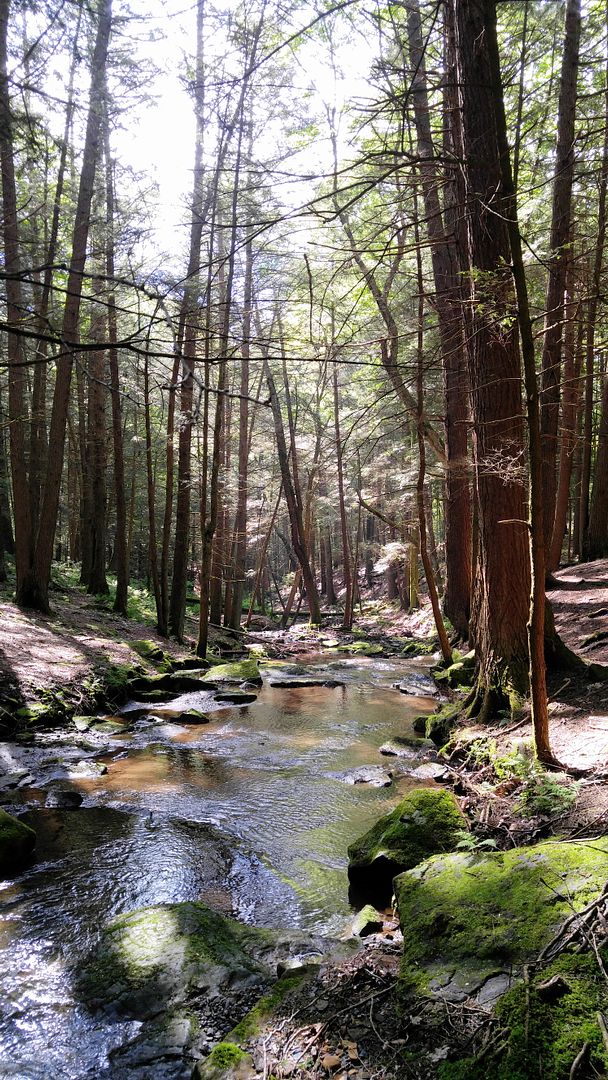
Beautiful mossy fast-moving creek with tall hemlocks reaching high overhead...
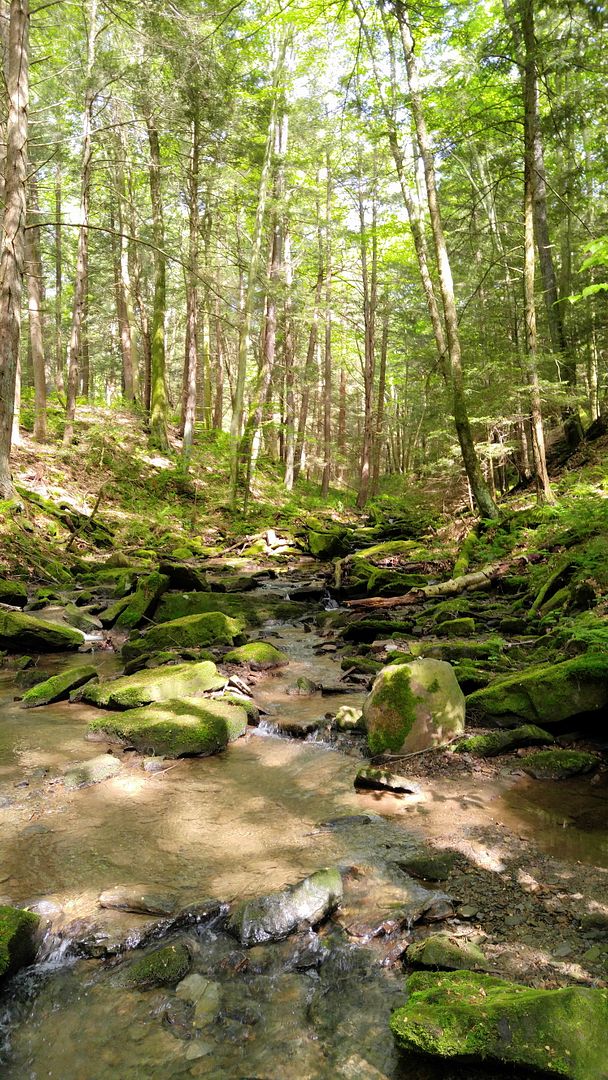
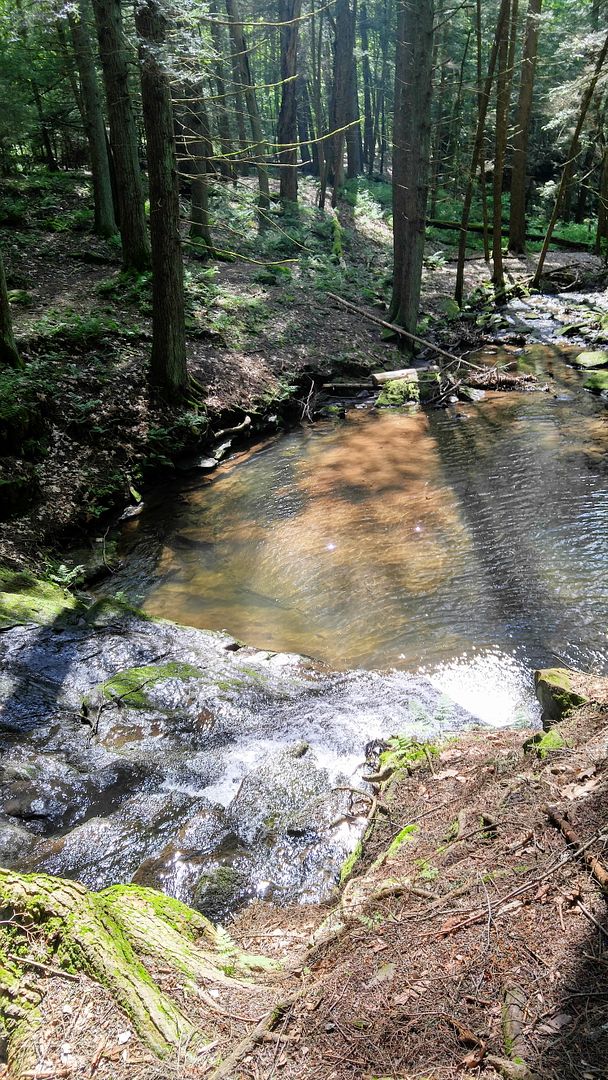
Here a brisk little waterfall plunges down and makes a pool below. It's hard to tell how deep it is.
Next time I come here, there's absolutely no question about it... I will be wearing heavy waterproof books and bring a good set of thick gloves, and I WILL be climbing around in the creek and turning over rocks and climbing all over everything.
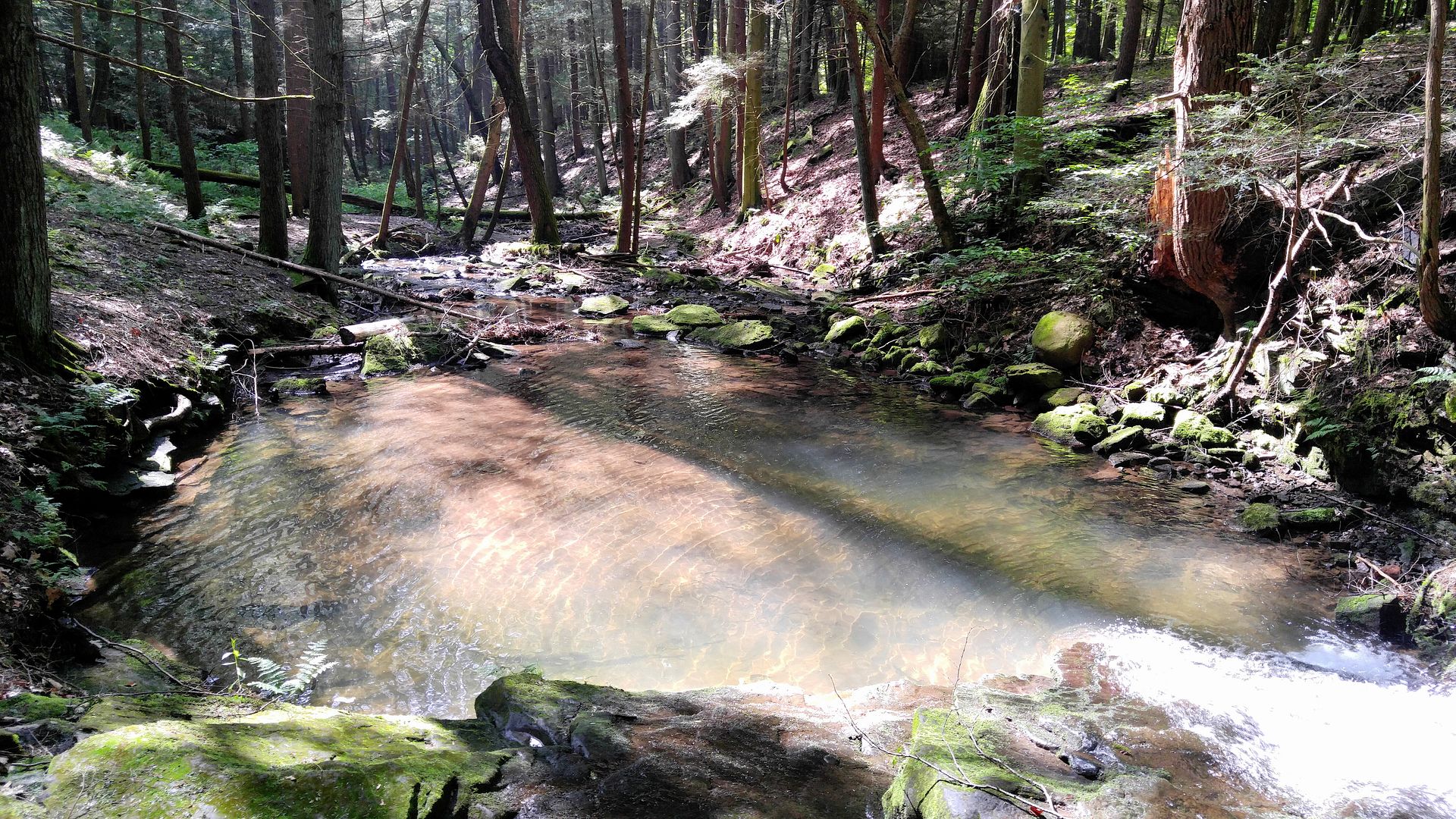
Another shot of the pool beneath the waterfall. The angle of the light made it just about impossible to get an actual picture of the waterfall itself to show up.
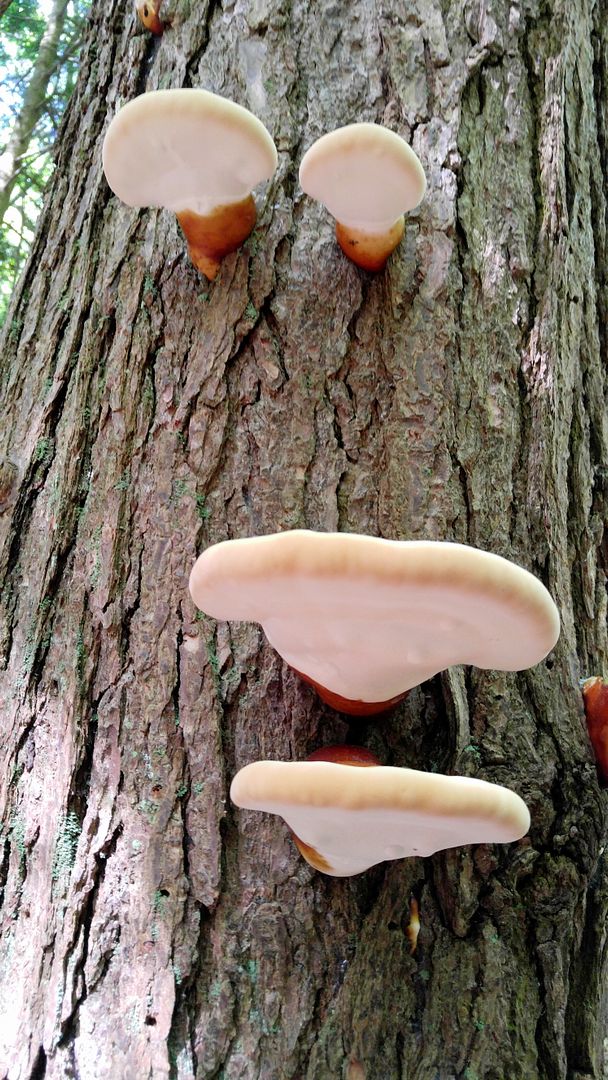
I looked up and spotted these marvelous things on the trunk of a hemlock, but I had no idea HOW marvelous they were until I found some closer to the ground!
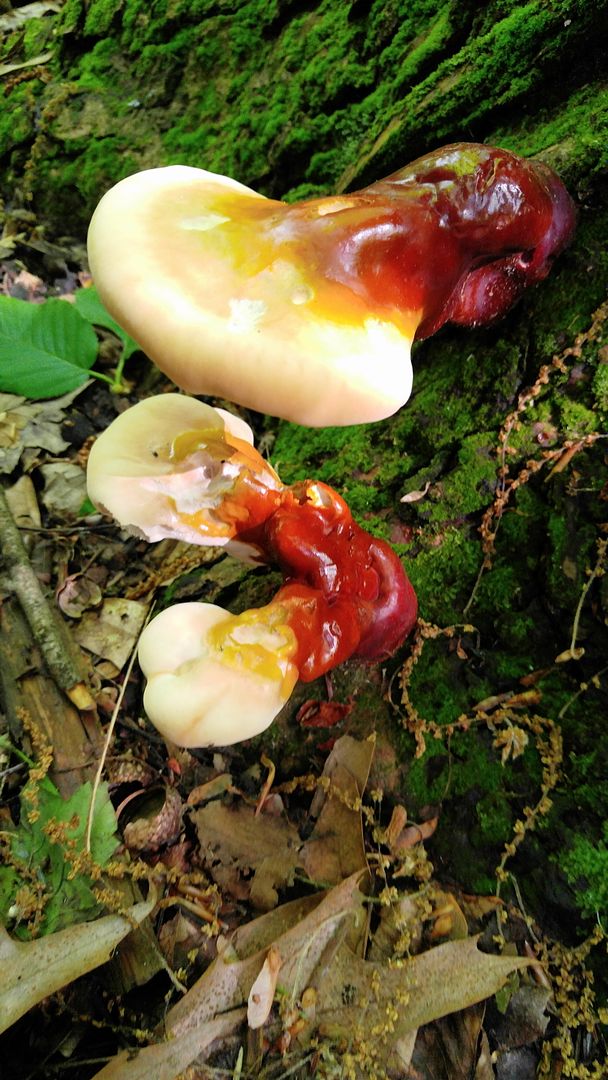
This is Ganoderma tsugae, the hemlock varnish shelf. Finding it on a hemlock was critical to the identification, since finding such a wild and wonderful shelf growing specifically on one species of tree is very helpful.
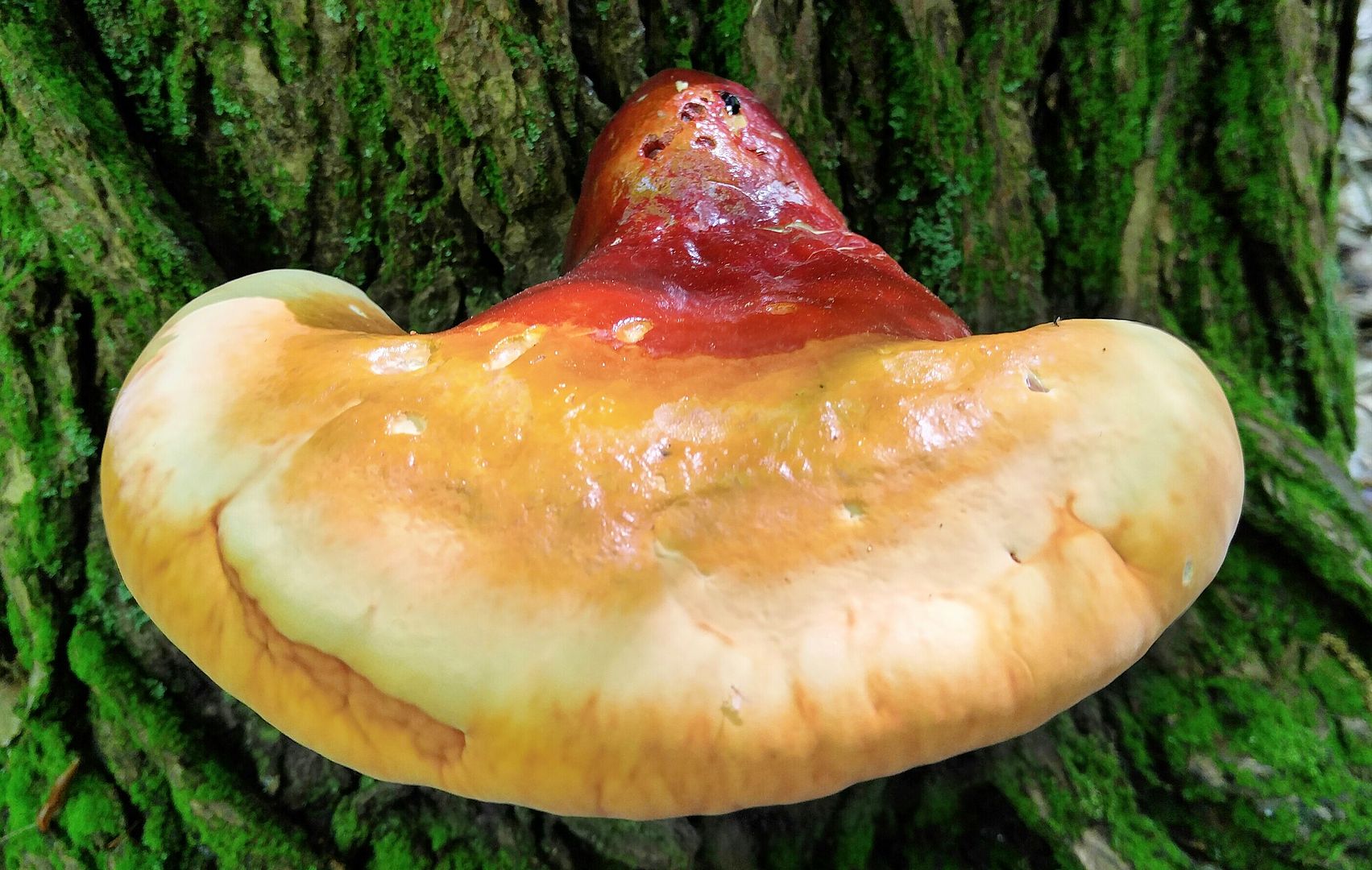
This stunning beauty is a close relative of Ganoderma lucidum, known in various parts of Asia as Lingzhi and Reishi, a mushroom of powerful medicinal abilities. It is actually so closely related that some practitioners of mushroom medicine consider tsugae to be almost or just as good as its Asian relatives.
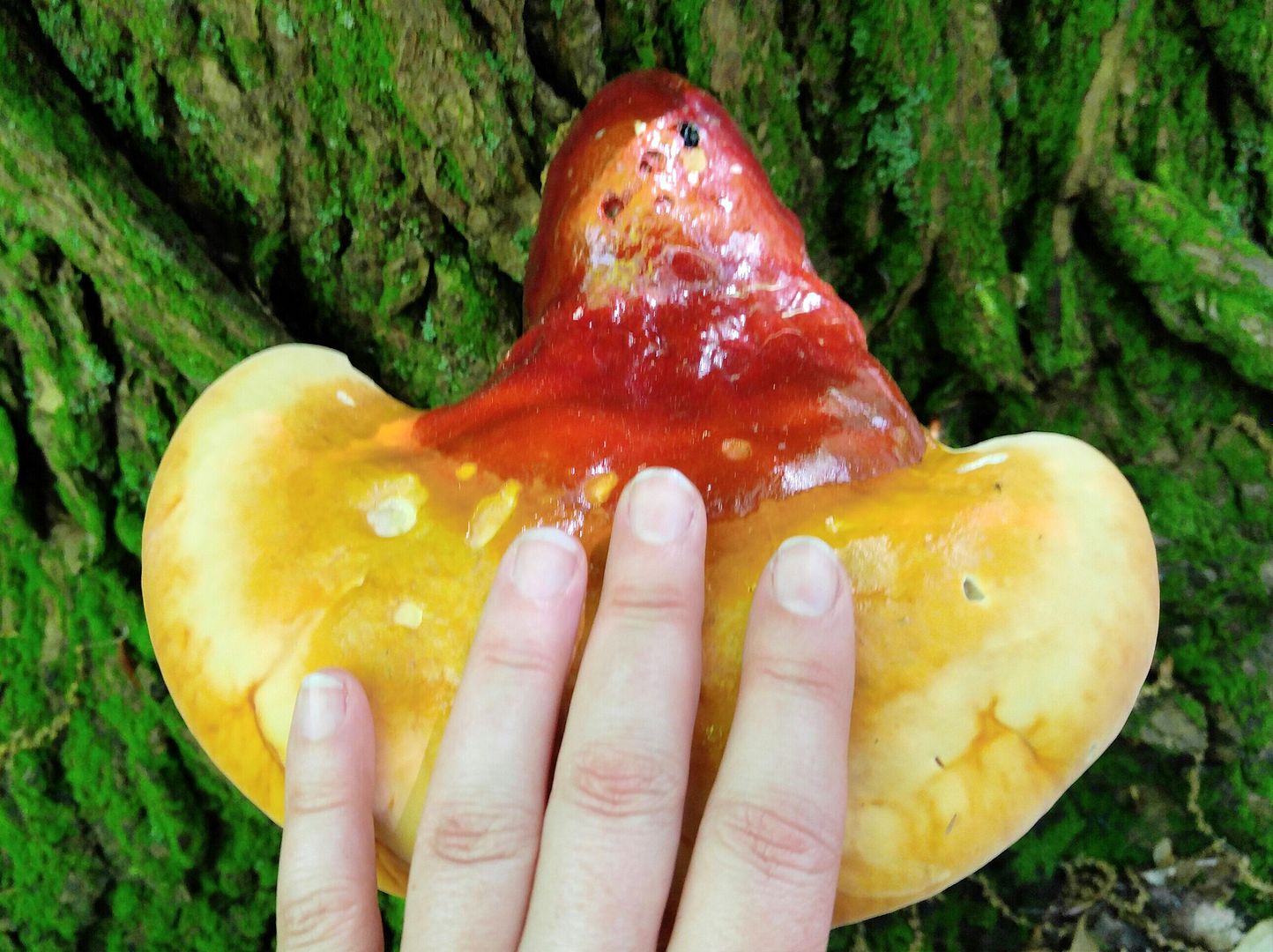
They aren't really edible in the sense that you'd have them as part of a meal... they basically feel like dense cork. Despite the shiny appearance they are not slimy at all... the shine is actually much more like a varnish, making the common name accurate.
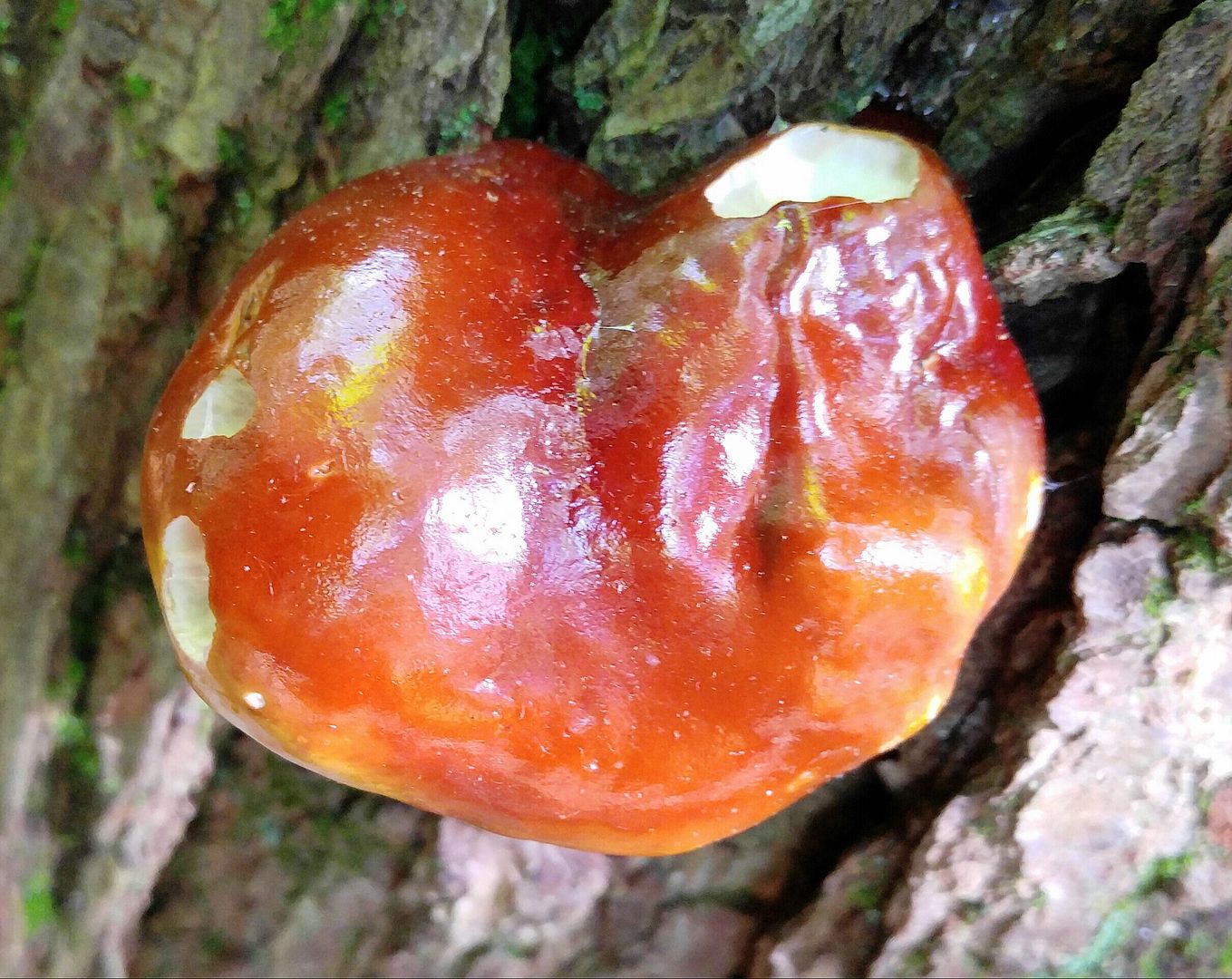
This baby (already eaten in spots) is still covered by the "varnish", which appears to be something like the veil on some other mushrooms. It's shiny, slick, and quite dry... not even remotely slimy.

These beauties were a stunning find that made the entire walk worthwhile on their own, even if the rest of it hadn't been so wonderful. But I also found these...
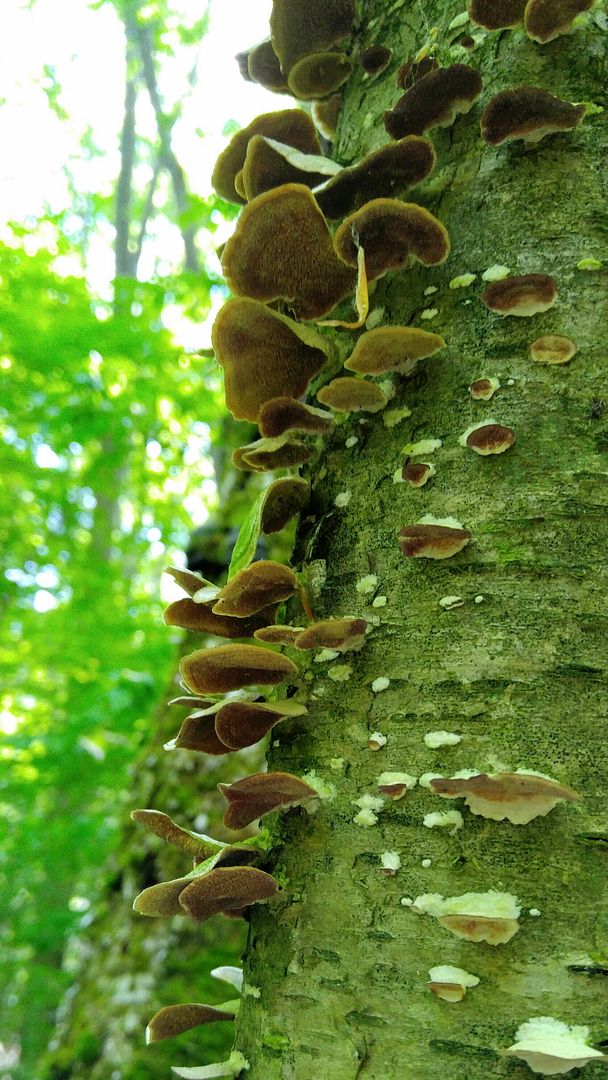
Pretty little shelves...
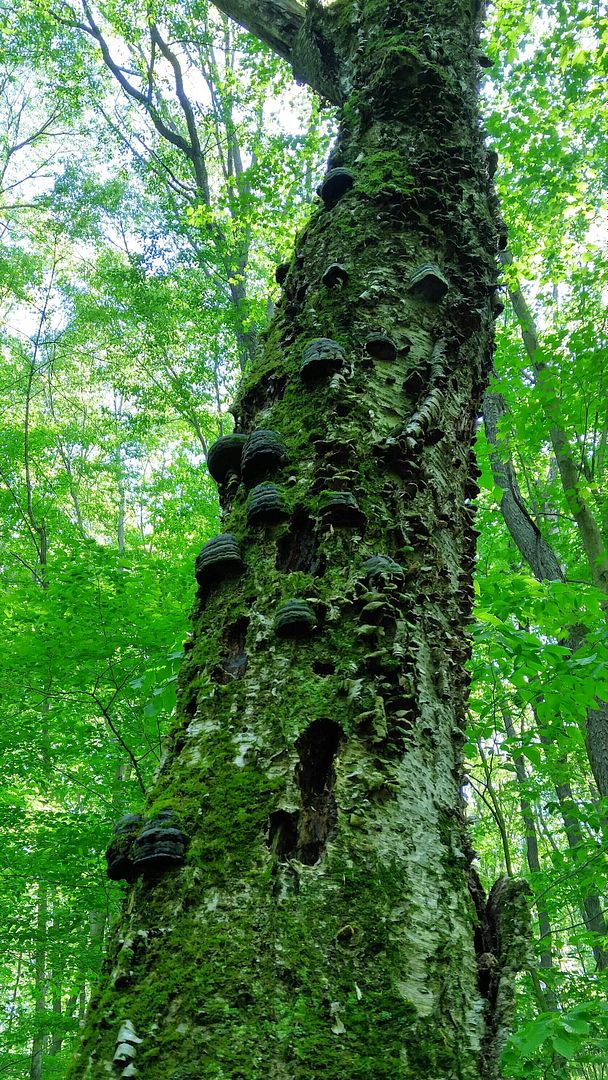
And dark, lumpy conks. Possibly the common Fomes fomentarius, sometimes called the tinder fungus. It's quite cosmopolitan and likes a wide variety of trees, where it is an active parasite and busily kills its hosts, then decays their fallen remains.
And this...
I've found plenty of deer skeletons. With as heavily as they are hunted here (and with the overpopulation to require this level of hunting) their remains do tend to turn up, but usually in the context of human intervention. Most of the ones I've found have had saw marks on the bones... ribs cut off, leg bones sawed through, heads missing, etc. None of them have had hooves that I could find... when a deer's hide is removed the hooves and small bones of the lower leg usually go with it.
This one...
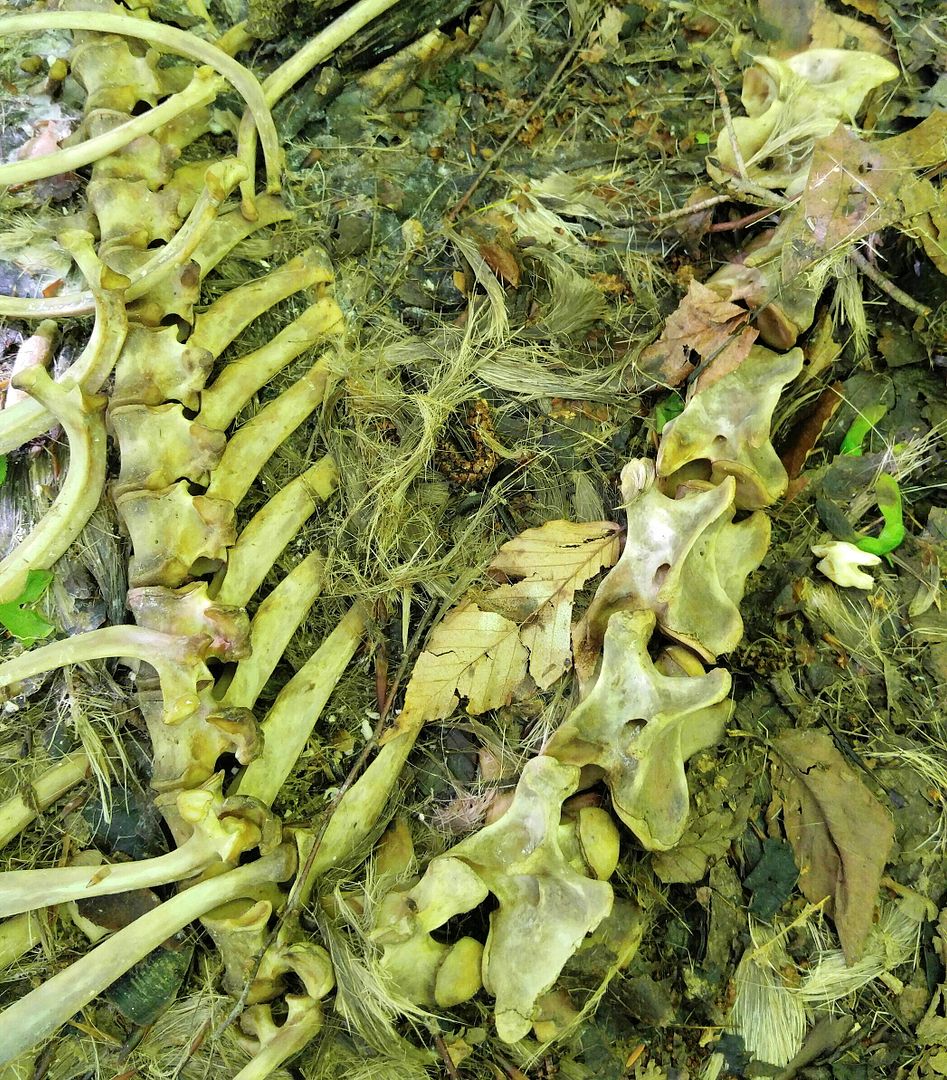
Not only are the ribs still perfectly placed along the spine, but the vertebrae are still attached. The odd arch of the back isn't that odd... rigor mortis will tend to bend vertebrates with strong back muscles into this position.
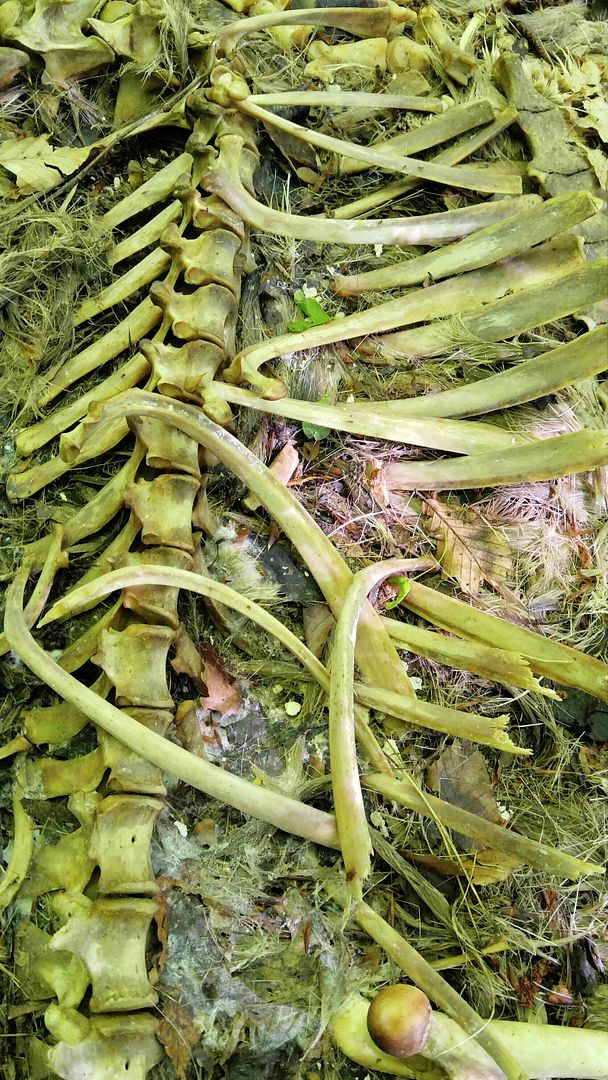
These vertebrae are perfectly lined up, and there's still fur all over the place. Skin will go long before fur does... keratin is much harder to digest than flesh.
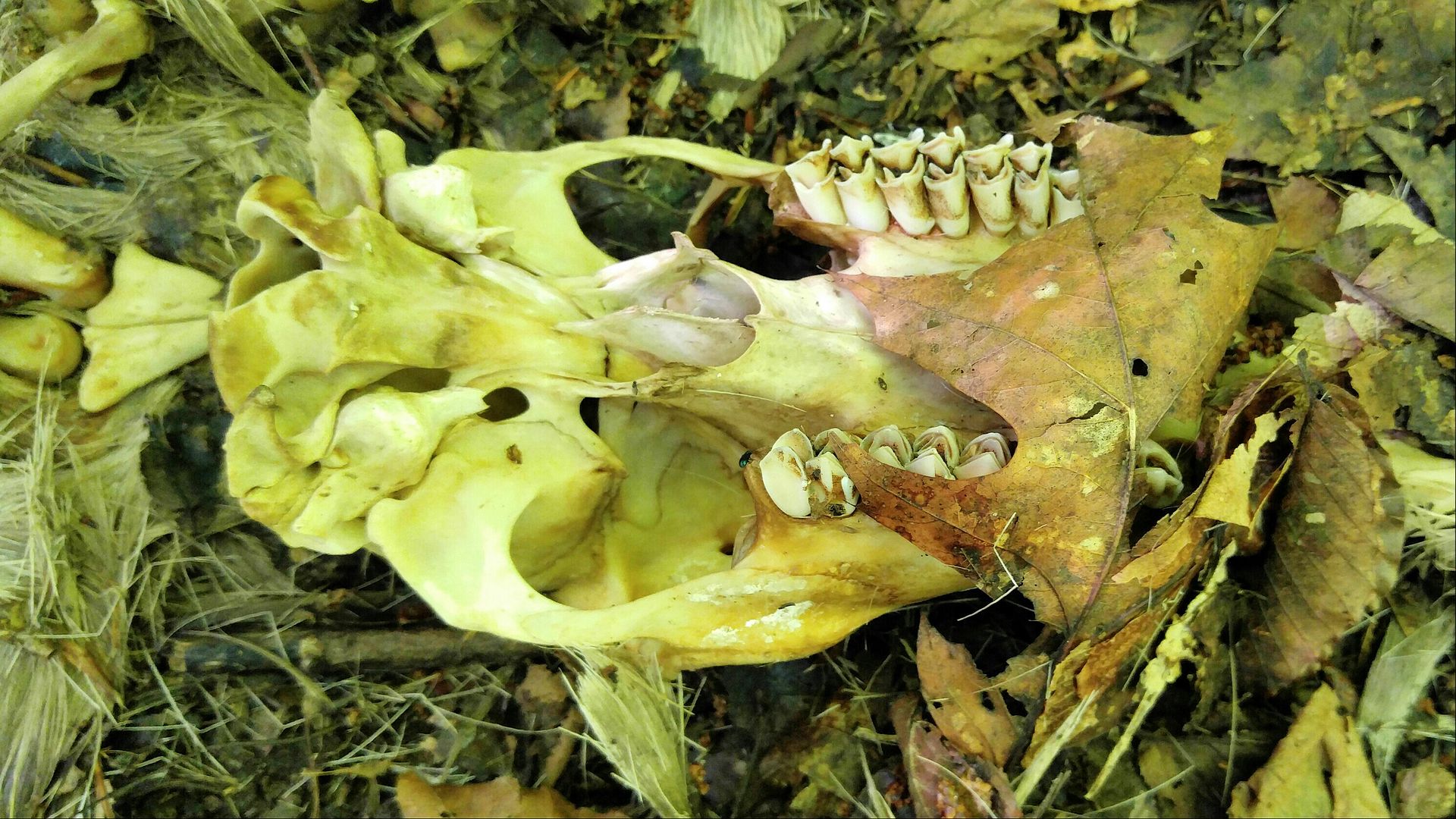
The skull, at the end of the spine, with all its teeth and some of the tiny bones still attached... never found one so perfect. This thing laid here and decayed totally undisturbed, and it's fantastic to see.
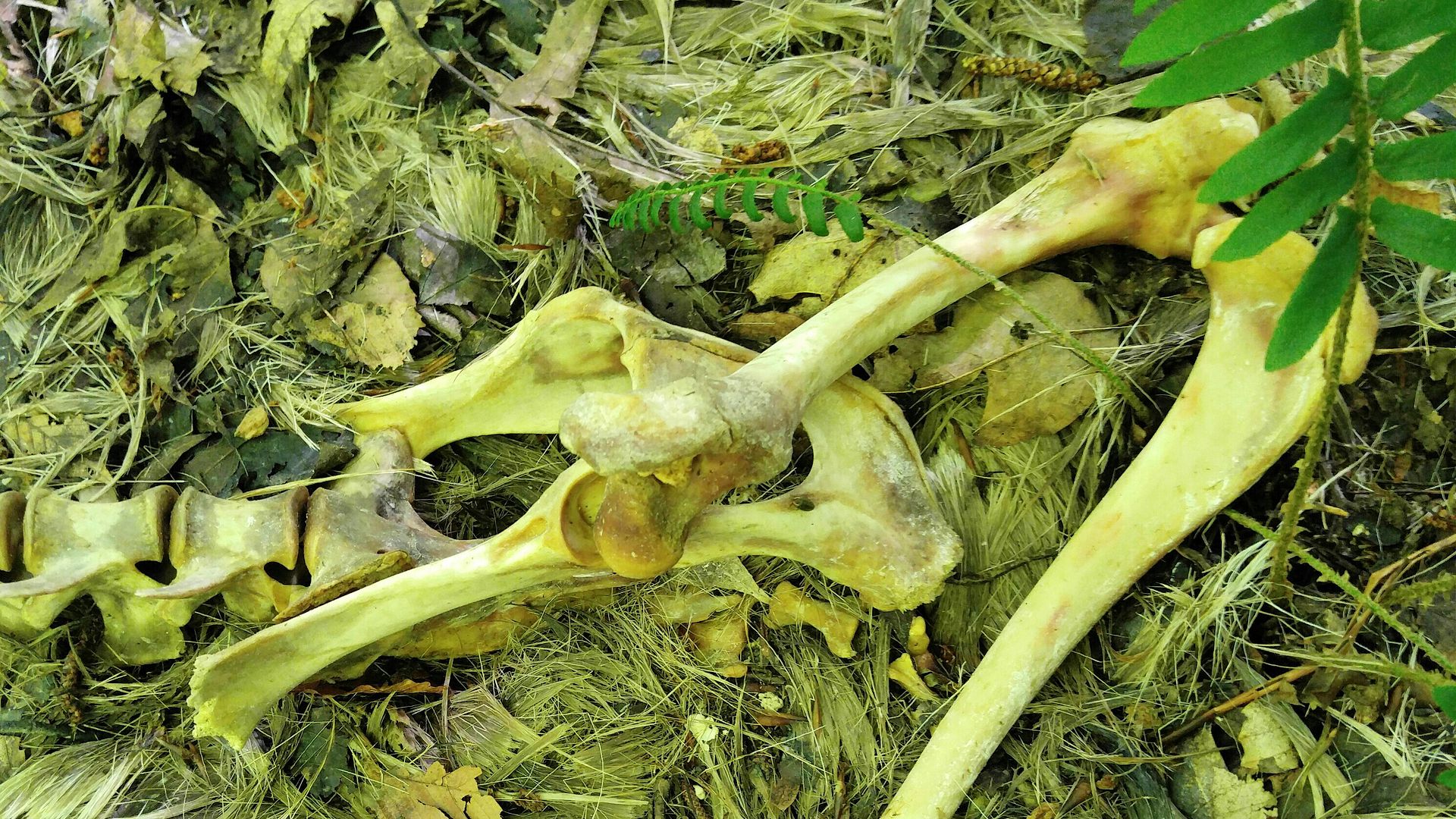
Joints of the upper leg and pelvis right where they should be...
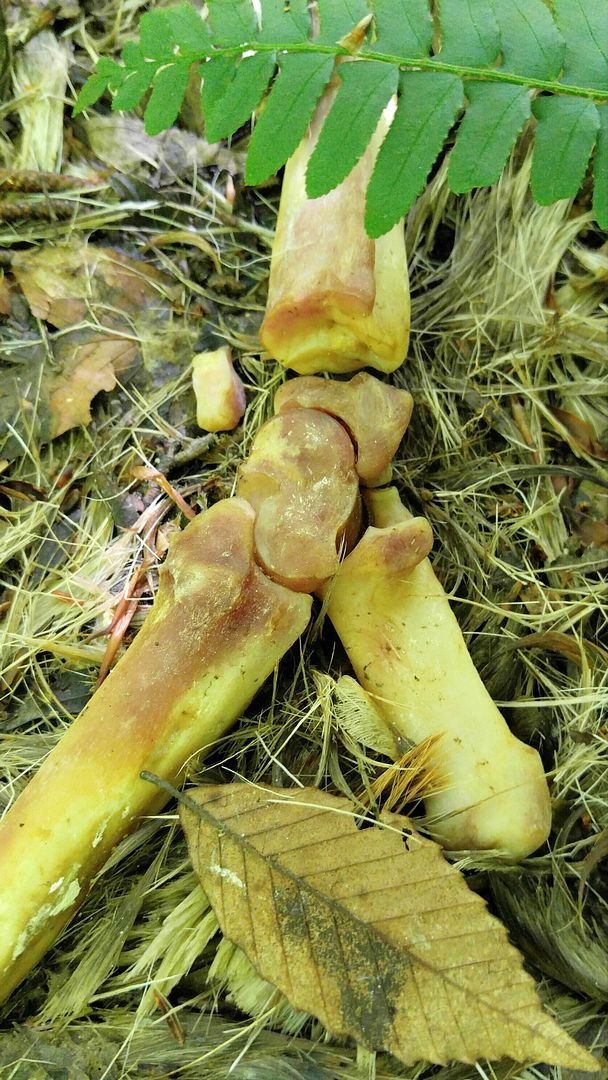
I have never, on a skeleton that hadn't been reassembled by a professional, seen a joint (I believe it is the ankle) so perfectly articulated, exactly as it would have been when it was alive and working. It's beautiful to see.
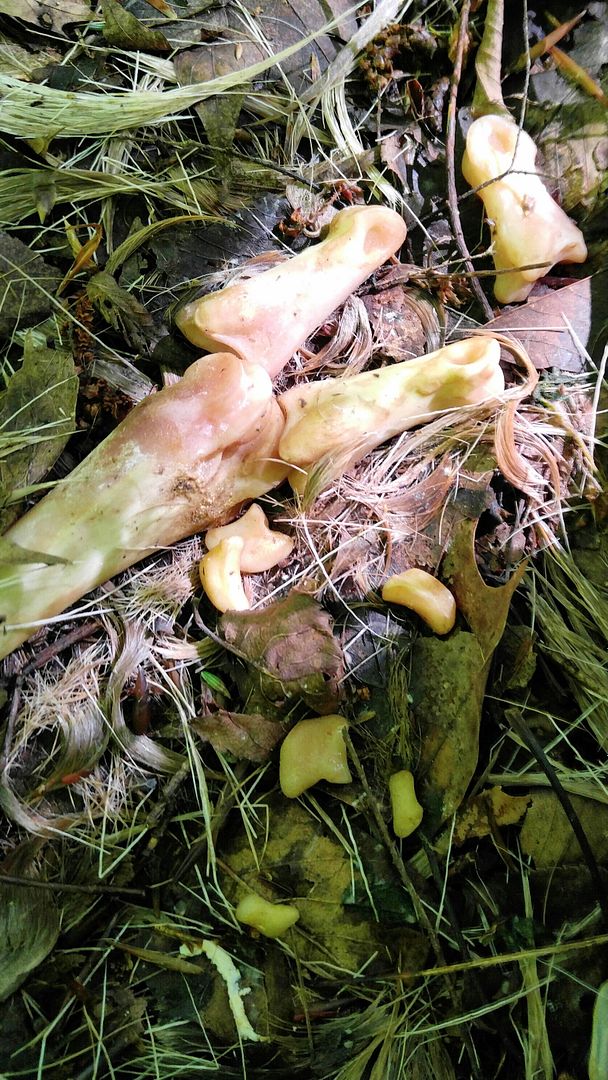
And possibly most marvelous... what I think these are!
Deer have two toes (well, three, but they walk on two), and they stand on the tips of them, with the two sections of hoof covering the ends. These are the bones of the toes and even the tiny little ones from the tips. They are not teeth... first of all, the skull wasn't missing any, and deer teeth have very distinctive edges for tearing and eating a rough variety of plants. Nope... these are toes!
And there are people who would think it strange that I spent a whole afternoon in this wonderful place full of life, and here I am fascinated and entranced by death. It's not death that I'm fascinated by, not at all. Fungi do not represent decay or dying to me... they are extraordinary organisms solving the puzzles of digesting their environment with an incredibly complex suite of enzymes, and if that environment happens to still be alive at the time, that is not the concern of the fungus in the least. And the skeleton is no symbol of death to me either. It's a monument to the work of evolution that produced such a weird, random, beautifully functional but logically nonsensical assemblage of an internal support structure. It is nature revealed and it is beautiful.
These things are gifts given to me by chance or fate or the universe or nothing at all, but I am fortunate to have been in this place at this time and to be allowed to see these things, and I am grateful. Not to some higher power, but to the world that exists and has these things in it.
.
.
.
And yeah, some of the trails are like that, but a lot of what's down there isn't even trails at ALL, and it's fantastic. Fast-running creeks that cut deep ravines made the area too steep for farming, and there's an intense and beautiful ecosystem of hemlocks down there that's like nothing else I've seen anywhere around here. They are not true old-growth hemlocks, which can be astoundingly large, and the biggest of these were probably logged in the past, but some have been there a very long time.
I was quite disappointed that I had not come down here before...

Found these beauties before I even got to the trail. I believe they are some sort of inky cap... the blackened edges look like they may be in the process of dissolving themselves, which is what inky caps do, but it also makes them a bit hard to identify.

Shelf fungi are so hard to identify, especially as they've started to age a bit... these are not the classic dryad's saddle that I find most often, but I've seen these before too.

Beautiful mossy fast-moving creek with tall hemlocks reaching high overhead...


Here a brisk little waterfall plunges down and makes a pool below. It's hard to tell how deep it is.
Next time I come here, there's absolutely no question about it... I will be wearing heavy waterproof books and bring a good set of thick gloves, and I WILL be climbing around in the creek and turning over rocks and climbing all over everything.

Another shot of the pool beneath the waterfall. The angle of the light made it just about impossible to get an actual picture of the waterfall itself to show up.

I looked up and spotted these marvelous things on the trunk of a hemlock, but I had no idea HOW marvelous they were until I found some closer to the ground!

This is Ganoderma tsugae, the hemlock varnish shelf. Finding it on a hemlock was critical to the identification, since finding such a wild and wonderful shelf growing specifically on one species of tree is very helpful.

This stunning beauty is a close relative of Ganoderma lucidum, known in various parts of Asia as Lingzhi and Reishi, a mushroom of powerful medicinal abilities. It is actually so closely related that some practitioners of mushroom medicine consider tsugae to be almost or just as good as its Asian relatives.

They aren't really edible in the sense that you'd have them as part of a meal... they basically feel like dense cork. Despite the shiny appearance they are not slimy at all... the shine is actually much more like a varnish, making the common name accurate.

This baby (already eaten in spots) is still covered by the "varnish", which appears to be something like the veil on some other mushrooms. It's shiny, slick, and quite dry... not even remotely slimy.

These beauties were a stunning find that made the entire walk worthwhile on their own, even if the rest of it hadn't been so wonderful. But I also found these...

Pretty little shelves...

And dark, lumpy conks. Possibly the common Fomes fomentarius, sometimes called the tinder fungus. It's quite cosmopolitan and likes a wide variety of trees, where it is an active parasite and busily kills its hosts, then decays their fallen remains.
And this...
I've found plenty of deer skeletons. With as heavily as they are hunted here (and with the overpopulation to require this level of hunting) their remains do tend to turn up, but usually in the context of human intervention. Most of the ones I've found have had saw marks on the bones... ribs cut off, leg bones sawed through, heads missing, etc. None of them have had hooves that I could find... when a deer's hide is removed the hooves and small bones of the lower leg usually go with it.
This one...

Not only are the ribs still perfectly placed along the spine, but the vertebrae are still attached. The odd arch of the back isn't that odd... rigor mortis will tend to bend vertebrates with strong back muscles into this position.

These vertebrae are perfectly lined up, and there's still fur all over the place. Skin will go long before fur does... keratin is much harder to digest than flesh.

The skull, at the end of the spine, with all its teeth and some of the tiny bones still attached... never found one so perfect. This thing laid here and decayed totally undisturbed, and it's fantastic to see.

Joints of the upper leg and pelvis right where they should be...

I have never, on a skeleton that hadn't been reassembled by a professional, seen a joint (I believe it is the ankle) so perfectly articulated, exactly as it would have been when it was alive and working. It's beautiful to see.

And possibly most marvelous... what I think these are!
Deer have two toes (well, three, but they walk on two), and they stand on the tips of them, with the two sections of hoof covering the ends. These are the bones of the toes and even the tiny little ones from the tips. They are not teeth... first of all, the skull wasn't missing any, and deer teeth have very distinctive edges for tearing and eating a rough variety of plants. Nope... these are toes!
And there are people who would think it strange that I spent a whole afternoon in this wonderful place full of life, and here I am fascinated and entranced by death. It's not death that I'm fascinated by, not at all. Fungi do not represent decay or dying to me... they are extraordinary organisms solving the puzzles of digesting their environment with an incredibly complex suite of enzymes, and if that environment happens to still be alive at the time, that is not the concern of the fungus in the least. And the skeleton is no symbol of death to me either. It's a monument to the work of evolution that produced such a weird, random, beautifully functional but logically nonsensical assemblage of an internal support structure. It is nature revealed and it is beautiful.
These things are gifts given to me by chance or fate or the universe or nothing at all, but I am fortunate to have been in this place at this time and to be allowed to see these things, and I am grateful. Not to some higher power, but to the world that exists and has these things in it.
.
.
.